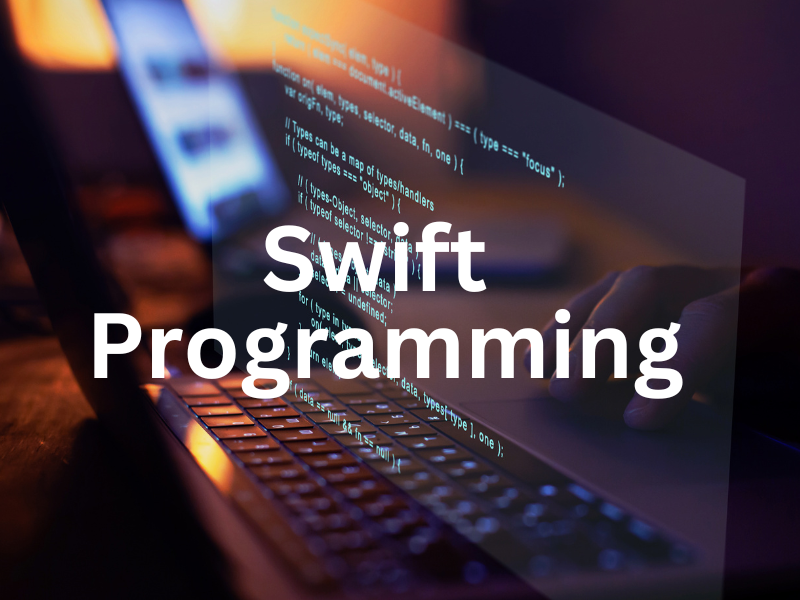Introduction
In an era driven by technology, mobile applications have become an integral part of our daily lives. Behind these innovative apps lies the power of programming languages, with Swift programming leading the charge. This advanced language, developed by Apple, has revolutionized mobile app development with its agility, performance, and intuitive syntax. If you’re ready to embark on your journey as a mobile app developer, buckle up and prepare to explore the exciting landscape of Swift programming.
Swift Programming: An Introduction to Modern Development

Programming languages play a key role in transforming ideas into code, and Swift has emerged as a prominent player in the realm of mobile app development. Swift programming offers a wide array of features and functionalities that make it an attractive choice for developers seeking to build robust and user-friendly applications.
What is Swift programming?
Swift programming is a modern, open-source programming language developed by Apple Inc. in 2014. Its primary purpose is to enhance the development of macOS, iOS, watchOS, and tvOS applications. With its concise syntax, it promotes fast and safe coding practices, increasing development speed and reducing application errors. Swift programming is a powerful tool that combines the best features of C, Objective-C, and other programming languages, making it an ideal choice for developers.
Why choose Swift for mobile app development?
- Performance: Swift programming is known for its exceptional speed and performance, thanks to its advanced compiler optimization techniques. It leverages the power of the LLVM (Low-Level Virtual Machine) compiler to deliver lightning-fast execution times, ensuring smooth user experiences.
- Safety: With its modern syntax, Swift programming promotes safer coding practices. Its type inference system helps developers catch errors at compile time, reducing the chances of runtime crashes and improving code reliability.
- Expressive and Intuitive: Swift programming offers an intuitive and easy-to-understand syntax that allows developers to write clean and concise code. Its readability and expressiveness make it a pleasure to work with, significantly enhancing productivity and maintainability.
- Interoperability: Swift programming seamlessly works with Objective-C, allowing developers to leverage existing codebases and libraries. This interoperability ensures a smooth transition for developers familiar with Objective-C, while also providing access to Apple’s vast ecosystem of frameworks and libraries.
Getting Started with Swift Programming: A Step-by-Step Guide

Congratulations on taking the first step towards mastering Swift programming. In this section, we’ll guide you through the process of setting up your development environment, exploring essential tools, and getting started with your first Swift project.
Setting up your Swift environment
To begin your Swift journey, you need to set up the appropriate development environment. Here’s a step-by-step guide to get you started: 1. Install Xcode: Xcode is Apple’s integrated development environment (IDE) for macOS and iOS development. It includes all the necessary tools, compilers, and frameworks for Swift programming. Head to the Apple App Store, download Xcode, and follow the installation instructions. 2. Swift Playgrounds: Swift Playgrounds is an interactive coding environment that allows you to experiment with Swift programming on your iPad or Mac. Install Swift Playgrounds from the App Store to practice and explore Swift concepts in an engaging manner. 3. Terminal Setup: The Terminal app in macOS provides a command-line interface to interact with the operating system, including Swift tools. Familiarize yourself with Terminal to access Swift’s command-line tools, package managers, and more.
Swift Syntax: The Building Blocks of Modern Mobile Development

To effectively harness the power of Swift programming, it’s crucial to understand its syntax and core concepts. Let’s dive into the foundational building blocks of Swift development:
Variables and Constants
In Swift, variables and constants are used to store and manipulate data. Understanding the difference between the two is essential: – Variables: Variables are mutable and can be reassigned with new values. – Example: var age: Int = 25 – Constants: Constants are immutable and cannot be changed once assigned. – Example: let name: String = "John"
Data Types in Swift
Swift offers a range of data types to handle different kinds of data. Here are a few commonly used ones: – Int: Represents whole numbers (e.g., 7, -2, 0). – Double and Float: Used for storing decimal numbers with different levels of precision. – String: Represents sequences of characters, such as names or text. – Bool: Represents Boolean values, either true or false.
Control Flow in Swift
Control flow allows developers to execute code conditionally or repeatedly based on specific requirements. Let’s explore some essential control flow constructs in Swift: – If-else Statements: Used to execute different blocks of code based on given conditions. – Example: if temperature > 25 { print("It's a hot day!") } else { print("Enjoy the weather!") } – Loops: Swift offers various loop constructs, such as for-in loops and while loops, to iterate over collections or perform repetitive tasks. – Example: for number in 1...5 { print(number) }
Building a Swift App: From Idea to Execution
Once you’re comfortable with Swift’s syntax and core concepts, it’s time to start building your first app. In this section, we’ll take you through the step-by-step process of transforming your creative ideas into functional iOS applications.
Project Planning: Ideation and Wireframing
Before diving into code, it’s crucial to plan your project effectively. Start by brainstorming your app’s core features, functionality, and target audience. Create wireframes or mockups to visualize the user interface, screen flow, and overall structure of your app.
Design and User Interface
A captivating and user-friendly design is essential for the success of any mobile application. Swift programming offers seamless integration with Apple’s UIKit framework, making it easy to create visually appealing interfaces. Leverage Swift’s Auto Layout system to ensure proper adaptation to different screen sizes and orientations.
Implementing App Logic
The logic behind your app drives its functionality and user experience. Utilize Swift’s powerful capabilities to implement complex business logic, such as data processing, networking, and user input handling. Leverage Swift libraries and frameworks to enhance your app’s capabilities and save development time.
Testing and Debugging
Thoroughly testing your app helps identify and rectify any potential issues before deployment. Swift programming provides robust testing frameworks, such as XCTest, to ensure your app’s stability and reliability. Use Xcode’s debugging tools to track down and fix bugs quickly and efficiently.
Frequently Asked Questions (FAQs)
Q: Is Swift difficult to learn for beginners?
Learning any programming language requires dedication and practice, but Swift is considered beginner-friendly. Its simple syntax, clear error messages, and extensive documentation make it an excellent choice for aspiring developers.
Q: Can I develop Android apps with Swift?
Swift is primarily developed for use in iOS, macOS, watchOS, and tvOS applications. While efforts have been made to enable Swift development for Android, it’s recommended to use other languages like Java or Kotlin for Android app development.
Q: How can I transition from Objective-C to Swift?
Swift is designed to be compatible with Objective-C, allowing developers to seamlessly migrate their existing codebases. Apple provides comprehensive documentation and tools to facilitate a smooth transition, making it easier for Objective-C developers to embrace Swift.
Q: Where can I find resources to enhance my Swift programming skills?
There are numerous resources available to enhance your Swift skills: – Official Swift Documentation: Apple’s official documentation provides in-depth explanations and examples of Swift concepts and features. – Online Courses and Tutorials: Platforms like Udemy, Coursera, and Ray Wenderlich offer a wide range of Swift programming courses and tutorials. – Swift Community Forums and Blogs: Engaging with the Swift community on forums like Stack Overflow and reading popular Swift blogs can provide valuable insights and practical tips.
Conclusion
Swift programming has emerged as a game-changer in the world of mobile app development. Its performance, safety, and expressiveness make it an ideal choice for developers striving to create cutting-edge applications. By harnessing the power of Swift programming, you can unlock endless possibilities and bring your app ideas to life. So, what are you waiting for? Dive into the world of Swift programming and embark on an exciting journey of innovation and creativity.
